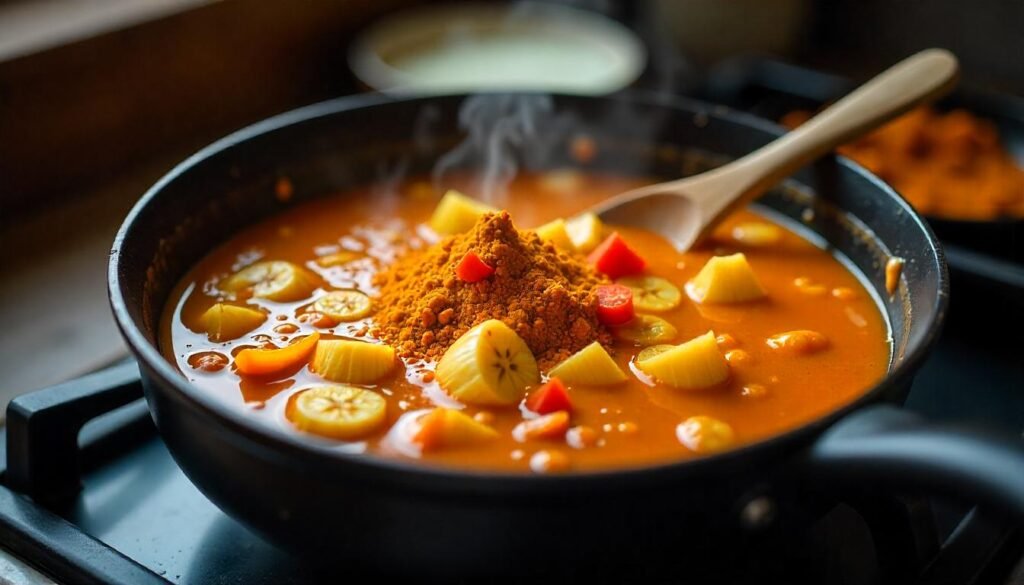
Indian Dishes: 10 Creative Fruit Peel Uses
Indian Dishes: 10 Creative Fruit Peel Uses
Indian Dishes: Explore 10 inventive ways to utilize fruit peels in Indian cuisine. Elevate flavors, minimize wastage, and introduce a distinctive element to your dishes with these ingenious suggestions.


Introduction
Brief Overview of the Benefits of Reusing Fruit Peels in Indian Cooking
Reusing fruit peels in Indian cooking is a fantastic way to enhance flavors, reduce waste, and make the most of every part of the fruit. These peels are often rich in nutrients and can add unique textures and tastes to your dishes.
Explanation of How Fruit Peels Can Enhance Flavors and Reduce Waste
Fruit peels contain essential oils and natural compounds that can intensify the flavors of your dishes. By incorporating them into your cooking, you not only add depth to your meals but also contribute to a more sustainable kitchen by reducing food waste.
Creative Use 1: Lemon Peel Chutney
Recipe and Steps to Make Lemon Peel Chutney
- Ingredients: Lemon peels, green chilies, ginger, garlic, mustard seeds, turmeric powder, salt, and oil.
- Steps:
- Boil the lemon peels until they are soft.
- Grind the boiled peels with green chilies, ginger, and garlic to form a paste.
- Heat oil in a pan, add mustard seeds and let them splutter.
- Add the paste, turmeric powder, and salt. Cook until the oil separates from the chutney.
Benefits of Using Lemon Peels in Chutney
Lemon peels add a tangy and zesty flavor to the chutney, making it a perfect accompaniment for various Indian dishes. They are also rich in vitamin C and antioxidants.

Creative Use 2: Orange Peel Pickle
Recipe and Steps to Make Orange Peel Pickle
- Ingredients: Orange peels, mustard seeds, fenugreek seeds, red chili powder, turmeric powder, salt, and oil.
- Steps:
- Cut the orange peels into small pieces.
- Dry roast mustard seeds and fenugreek seeds, then grind them into a powder.
- Heat oil in a pan, add the orange peels, and cook until they soften.
- Add the ground spices, red chili powder, turmeric powder, and salt. Mix well and cook for a few more minutes.
Benefits of Using Orange Peels in Pickles
Orange peels add a unique citrusy flavor to the pickle, enhancing its taste. They are also a good source of fiber and vitamin C.

Creative Use 3: Banana Peel Curry
Recipe and Steps to Make Banana Peel Curry
- Ingredients: Banana peels, onions, tomatoes, green chilies, garlic, ginger, turmeric powder, coriander powder, cumin seeds, salt, and oil.
- Steps:
- Clean and chop the banana peels into small pieces.
- Heat oil in a pan, add cumin seeds and let them splutter.
- Add chopped onions, garlic, and ginger. Sauté until golden brown.
- Add tomatoes, green chilies, turmeric powder, coriander powder, and salt. Cook until the tomatoes are soft.
- Add the banana peels and cook until they are tender.
Benefits of Using Banana Peels in Curry
Banana peels add a unique texture and flavor to the curry. They are rich in fiber, vitamins, and minerals, making the dish nutritious.

Creative Use 4: Watermelon Rind Sabzi
Recipe and Steps to Make Watermelon Rind Sabzi
- Ingredients: Watermelon rind, onions, tomatoes, green chilies, garlic, ginger, turmeric powder, cumin seeds, coriander powder, salt, and oil.
- Steps:
- Peel the green outer layer of the watermelon rind and chop the white part into small pieces.
- Heat oil in a pan, add cumin seeds and let them splutter.
- Add chopped onions, garlic, and ginger. Sauté until golden brown.
- Add tomatoes, green chilies, turmeric powder, coriander powder, and salt. Cook until the tomatoes are soft.
- Add the watermelon rind pieces and cook until they are tender.
Benefits of Using Watermelon Rind in Sabzi
Watermelon rind adds a crunchy texture to the sabzi. It is rich in vitamins A, C, and B6, as well as antioxidants.
Creative Use 5: Pomegranate Peel Tea
Recipe and Steps to Make Pomegranate Peel Tea
- Ingredients: Pomegranate peels, water, honey, and lemon juice.
- Steps:
- Dry the pomegranate peels and grind them into a powder.
- Boil water and add the pomegranate peel powder.
- Let it simmer for a few minutes, then strain the tea.
- Add honey and lemon juice to taste.
Benefits of Using Pomegranate Peels in Tea
Pomegranate peels are rich in antioxidants and can boost immunity. The tea has a unique flavor and offers various health benefits.
Creative Use 6: Apple Peel Jam
Recipe and Steps to Make Apple Peel Jam
- Ingredients: Apple peels, sugar, water, lemon juice, and cinnamon (optional).
- Steps:
- Collect apple peels from several apples.
- In a pot, combine the apple peels, sugar, water, and a splash of lemon juice.
- Bring to a boil, then reduce the heat and let it simmer until the mixture thickens.
- Add a pinch of cinnamon for extra flavor, if desired.
- Blend the mixture until smooth and store in sterilized jars.
Benefits of Using Apple Peels in Jam
Apple peels are rich in fiber and vitamins, making the jam nutritious. They also add a natural sweetness and a hint of tartness to the jam, enhancing its flavor.
Creative Use 7: Potato Peel Crisps
Recipe and Steps to Make Potato Peel Crisps
- Ingredients: Potato peels, olive oil, salt, and your favorite seasoning (e.g., paprika, garlic powder).
- Steps:
- Preheat the oven to 200°C (400°F).
- Toss the potato peels in olive oil, salt, and seasoning.
- Spread the peels in a single layer on a baking sheet.
- Bake for 15-20 minutes, or until crispy and golden brown.
- Let them cool before serving.
Benefits of Using Potato Peels in Crisps
Potato peels are packed with nutrients, including fiber, potassium, and vitamin C. Making crisps from potato peels is a delicious and healthy way to reduce food waste.
Creative Use 8: Carrot Peel Soup
Recipe and Steps to Make Carrot Peel Soup
- Ingredients: Carrot peels, onions, garlic, vegetable broth, olive oil, salt, and pepper.
- Steps:
- Heat olive oil in a pot and sauté chopped onions and garlic until translucent.
- Add the carrot peels and cook for a few minutes.
- Pour in the vegetable broth and bring to a boil.
- Reduce the heat and let it simmer until the carrot peels are tender.
- Blend the soup until smooth and season with salt and pepper.
Benefits of Using Carrot Peels in Soup
Carrot peels are rich in vitamins and antioxidants. Using them in soup adds a depth of flavor and ensures that no part of the carrot goes to waste.
Creative Use 9: Mango Peel Achar
Recipe and Steps to Make Mango Peel Achar
- Ingredients: Mango peels, mustard seeds, fenugreek seeds, red chili powder, turmeric powder, salt, and oil.
- Steps:
- Cut the mango peels into small pieces.
- Dry roast mustard seeds and fenugreek seeds, then grind them into a powder.
- Heat oil in a pan, add the mango peels, and cook until they soften.
- Add the ground spices, red chili powder, turmeric powder, and salt. Mix well and cook for a few more minutes.
Benefits of Using Mango Peels in Achar
Mango peels add a unique tangy flavor to the achar. They are also rich in antioxidants and vitamins, making the pickle both tasty and nutritious.
Creative Use 10: Pineapple Peel Juice
Recipe and Steps to Make Pineapple Peel Juice
- Ingredients: Pineapple peels, water, sugar, and lemon juice.
- Steps:
- Boil the pineapple peels in water with a bit of sugar until the peels are soft.
- Strain the mixture to remove the peels.
- Add a splash of lemon juice for extra flavor.
- Chill the juice before serving.
Benefits of Using Pineapple Peels in Juice
Pineapple peels are rich in vitamins and enzymes that aid digestion. Making juice from the peels is a refreshing and healthy way to utilize the entire fruit.
Conclusion
Recap of the 10 Creative Uses of Fruit Peels in Indian Cooking
- Lemon Peel Chutney
- Orange Peel Pickle
- Banana Peel Curry
- Watermelon Rind Sabzi
- Pomegranate Peel Tea
- Apple Peel Jam
- Potato Peel Crisps
- Carrot Peel Soup
- Mango Peel Achar
- Pineapple Peel Juice
Encouragement to Try These Recipes for a More Sustainable and Flavorful Kitchen
By incorporating these creative uses of fruit peels into your cooking, you can enhance the flavors of your dishes while reducing food waste. These recipes are not only delicious but also promote a more sustainable and eco-friendly kitchen.
Final Thoughts on the Importance of Reducing Waste in Cooking
Reducing waste in cooking is essential for a sustainable future. By finding innovative ways to use fruit peels, we can make the most of our ingredients and contribute to a healthier planet. Embrace these practices and enjoy the benefits of a zero-waste kitchen.
FAQs
- What are the benefits of reusing fruit peels in Indian cooking?
- Answer: Reusing fruit peels enhances flavors, reduces waste, and adds a unique twist to traditional dishes. It also promotes sustainable cooking practices.
- How can I make lemon peel chutney?
- Answer: To make lemon peel chutney, finely chop lemon peels and mix with spices, salt, and a bit of oil. Cook until the peels are soft and flavorful.
- What are some creative ways to use orange peels in cooking?
- Answer: Orange peels can be used to make pickles, added to desserts for a citrusy flavor, or used in marinades for a tangy twist.
- Can banana peels be used in curry?
- Answer: Yes, banana peels can be used in curry. They add a unique texture and flavor to the dish. Simply clean and chop the peels before adding them to the curry.
- How do I make watermelon rind sabzi?
- Answer: To make watermelon rind sabzi, peel the green outer layer and chop the white rind. Cook with spices, onions, and tomatoes until tender.
- What are the benefits of using pomegranate peels in tea?
- Answer: Pomegranate peels are rich in antioxidants and can add a unique flavor to tea. They also have potential health benefits, such as boosting immunity.
- How can I make apple peel jam?
- Answer: To make apple peel jam, simmer apple peels with sugar, water, and lemon juice until thickened. Blend until smooth and store in jars.
- Are potato peels safe to eat?
- Answer: Yes, potato peels are safe to eat and can be made into delicious crisps. Just wash them thoroughly and bake or fry until crispy.
- What is the best way to use carrot peels in soup?
- Answer: Add carrot peels to your soup stock for added flavor and nutrients. They can be blended into the soup for a smooth texture.
- How do I make pineapple peel juice?
- Answer: To make pineapple peel juice, boil the peels in water with a bit of sugar and lemon juice. Strain and chill before serving.
By incorporating these 10 creative uses of fruit peels into your Indian cooking, you can enhance flavors while reducing food waste. These recipes contribute to a more sustainable and eco-friendly kitchen, promoting a healthier planet. Embrace these practices for a zero-waste kitchen and enjoy the benefits of reducing waste in your cooking.
Read also: “10 Amazing Benefits of Cleaning with Fruit Peels”





One Comment
Pingback: